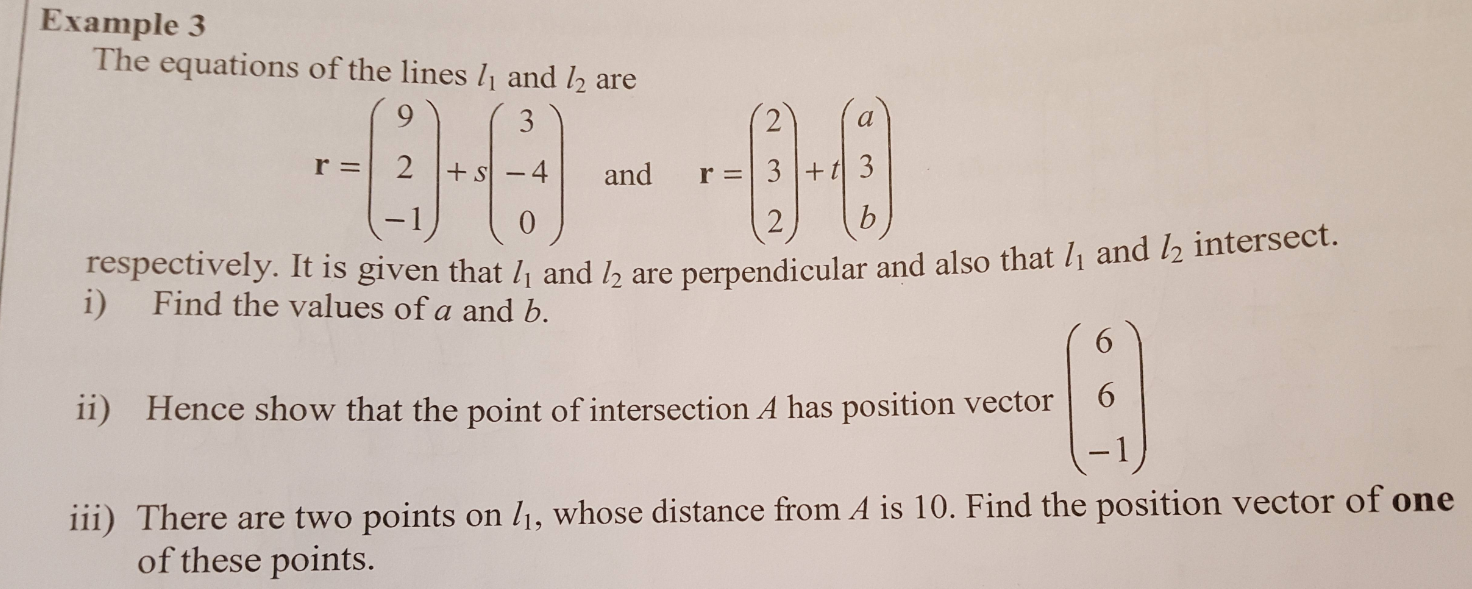[Core 4] 3D Coordinate Geometry

I found the first two parts easy, I got s = -1, t = 1, a = 4, and b = -3 which I assume is correct as I managed to show the position vector in part 2.
However, I really don't understand part 3. I don't even know where to start. I assume it involves Pythagoras somewhere but I'm not sure where to go with that.
Any help would be appreciated. Thanks in advance.
Scroll to see replies
Original post by DarkEnergy
Any help would be appreciated. Thanks in advance.
Any help would be appreciated. Thanks in advance.
You know that every single point on is of the form for some . So once you've found the required , you've found the point.
You know the distance between two points in terms of Pythagoras. Here, the distance will be:
Then square both sides, expand out the brackets, and solve for (it'll be a quadratic!) and then plug it back into the point.
Original post by Zacken
You know that every single point on is of the form for some . So once you've found the required , you've found the point.
You know the distance between two points in terms of Pythagoras. Here, the distance will be:
Then square both sides, expand out the brackets, and solve for (it'll be a quadratic!) and then plug it back into the point.
You know the distance between two points in terms of Pythagoras. Here, the distance will be:
Then square both sides, expand out the brackets, and solve for (it'll be a quadratic!) and then plug it back into the point.
I got 25s^2 + 40s - 71 = 0 as my quadratic which doesn't seem quite right as it would give weird numbers for my vector. I solved s on my calculator to be 1.0654 or -2.665. Is this right before I continue further? Thanks!
edit: just realised i put 40s instead of 50s.. gonna recalculate
(edited 7 years ago)
Original post by DarkEnergy
I got 25s^2 + 40s - 71 = 0 as my quadratic which doesn't seem quite right as it would give weird numbers for my vector. I solved s on my calculator to be 1.0654 or -2.665. Is this right before I continue further? Thanks!
Yup, you've definitely mixed up somewhere. You should have
Original post by DarkEnergy
I got 25s^2 + 40s - 71 = 0 as my quadratic which doesn't seem quite right as it would give weird numbers for my vector. I solved s on my calculator to be 1.0654 or -2.665. Is this right before I continue further? Thanks!
Check your expansion again.
Original post by Zacken
Yup, you've definitely mixed up somewhere. You should have
Original post by RDKGames
Check your expansion again.
Thanks.. can't believe I'm that rusty. I got s = 1 and s = -3, so I used s = 1 to get x = 12, y = -2, z = -1 as my final position vector. Is this correct?
Original post by DarkEnergy
Thanks.. can't believe I'm that rusty. I got s = 1 and s = -3, so I used s = 1 to get x = 12, y = -2, z = -1 as my final position vector. Is this correct?
Yep, either one would be okay.
Original post by Zacken
Yep, either one would be okay.
Thanks for your help!
Original post by DarkEnergy
Thanks for your help!
You're welcome!
Original post by gomc
how much harder is c4 geometry to c1 geometry?
Depends on the person. Subjectivity and all that, etc...
Original post by gomc
how much harder is c4 geometry to c1 geometry?
Different geometry approach. C4 deals with vectors and C1 deals with your normal every day x-y plane.
Original post by gomc
how much harder is c4 geometry to c1 geometry?
I didn't do very good in C1 last year (78 UMS) but I'm finding C4 to not be too bad so far, although my work ethic is a lot better this year so it might come down to that too.
Original post by B_9710
I think a simpler way to do these types of questions is to realise that a distance of 10 is 2 of the direction vectors. So 10 units either side of A on the line is the position vector .
I don't understand what you mean by the first part
Original post by DarkEnergy
I don't understand what you mean by the first part
If you start at any part on the line (A lies on the line), to get to any other point of the line, you need to move in the direction of (3, -4, 0). (which is why it's called the direction vector). If you move off in any other direction, you're no longer on the line.
So since the magnitude of (3, -4, 0) is 5. That means whenever you move in that direction by one "step" you move 5 units of distance away from A. So to get to the point on the line that's 10 units away from A, you start at A and move two "steps" in the direction (3, -4, 0) to get to the required point on the line. This can either be two units forward or two units backwards.
NB: I personally prefer this method myself, but it's not a very general one and I thought it'd confuse you a bit at first - which is why I went with my previous explanation, since you were already thinking along the lines of Pythagoras.
Original post by Zacken
If you start at any part on the line (A lies on the line), to get to any other point of the line, you need to move in the direction of (3, -4, 0). (which is why it's called the direction vector). If you move off in any other direction, you're no longer on the line.
So since the magnitude of (3, -4, 0) is 5. That means whenever you move in that direction by one "step" you move 5 units of distance away from A. So to get to the point on the line that's 10 units away from A, you start at A and move two "steps" in the direction (3, -4, 0) to get to the required point on the line. This can either be two units forward or two units backwards.
NB: I personally prefer this method myself, but it's not a very general one and I thought it'd confuse you a bit at first - which is why I went with my previous explanation, since you were already thinking along the lines of Pythagoras.
So since the magnitude of (3, -4, 0) is 5. That means whenever you move in that direction by one "step" you move 5 units of distance away from A. So to get to the point on the line that's 10 units away from A, you start at A and move two "steps" in the direction (3, -4, 0) to get to the required point on the line. This can either be two units forward or two units backwards.
NB: I personally prefer this method myself, but it's not a very general one and I thought it'd confuse you a bit at first - which is why I went with my previous explanation, since you were already thinking along the lines of Pythagoras.
Ah right cheers, I get it now. On a side note, how many marks do you think this whole question would be worth in an exam?
Original post by DarkEnergy
Ah right cheers, I get it now. On a side note, how many marks do you think this whole question would be worth in an exam?
Probably around 3 marks
Original post by B_9710
I think a simpler way to do these types of questions is to realise that a distance of 10 is 2 of the direction vectors. So 10 units either side of A on the line is the position vector .
There is a more general version of this (very useful) approach, based on the realisation that can be restated as:
(Remember that any point on the line will do for the first part of the vector line equation, and we might as well use the point A). A general point on the line is then
If we use that to represent some other point on the line, which we'll call B, the vector extending from A to B is
It's then quite easy to find the value(s) of for which and then to substitute those value(s) back into the (revised) line equation.
(edited 7 years ago)
Original post by old_engineer
(..)
Thank you very much!
Quick Reply
Related discussions
- Porisation A level chemistry
- A Level Mechanics.
- Edexcel IGCSE Higher tier Mathematics A Paper 1 1H (4MA1) - 19th May 2023 [Exam Chat]
- Trampoline Exercises That Will Challenge Your Body
- Maths A Level Coordinate Geometry Question
- A Level Maths revision issue. E/U —> A
- what laptop/Mac/ computer is recommended for doing a BA animation?
- First question from my further maths
- 3D Vectors
- vectors in 3d a level maths
- AS further maths - edexcel
- Chemistry planar question
- maths xyz plane question
- A Level Maths advice and help
- Is a 3D-Design GCSE useful for Architecture?
- Solve Vector Calculus problem
- coordinate geometry
- Coordinate Geometry - A-level Mathematics
- Calculating volume
- Further math vecotr question
Latest
Last reply 1 minute ago
scholarships with sports studies science degree in KoreaPosted 4 minutes ago
Has teaching started again for all courses at huddersfield uni?Last reply 5 minutes ago
University of OXford Postgraduate and Graduate funding 2022Last reply 15 minutes ago
SIP civil service 2024 threadLast reply 16 minutes ago
University of Oxford 2025 Undergraduate Applicants Official ThreadLast reply 20 minutes ago
Official University of Edinburgh Offer Holders Thread for 2024 entryLast reply 24 minutes ago
Official: Queen's University Belfast A100 2024 Entry ApplicantsLast reply 26 minutes ago
My boyfriend left me because he said my breasts and butt were too smallLast reply 32 minutes ago
Official Dental Hygiene and Therapy (Oral Health Science) 2024 Entry ThreadDentistry
2794
Posted 36 minutes ago
Please could someone mark this Macbeth essay, AQA mark schemeLast reply 39 minutes ago
What'll happen if a uni told me that my application is given to other schools?Trending
Last reply 1 week ago
Edexcel A Level Mathematics Paper 2 unofficial mark scheme correct me if wrongMaths
71
Trending
Last reply 1 week ago
Edexcel A Level Mathematics Paper 2 unofficial mark scheme correct me if wrongMaths
71




